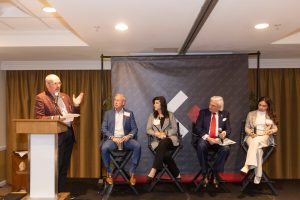Writer: Ryan Gandolfo
 2 min read February 2024 — South Florida and Broward County, in particular, have experienced periods of transformational growth over the last 100 years, from the Florida land boom in the 1920s to post-World War II population surge and more recently as the world’s yachting capital and national tourism destination. But regional leaders are attuned to the need for responsible growth in Greater Fort Lauderdale to emulate past successes in the next centennial.
2 min read February 2024 — South Florida and Broward County, in particular, have experienced periods of transformational growth over the last 100 years, from the Florida land boom in the 1920s to post-World War II population surge and more recently as the world’s yachting capital and national tourism destination. But regional leaders are attuned to the need for responsible growth in Greater Fort Lauderdale to emulate past successes in the next centennial.
“Sustainability is here to stay, or we will not be here,” said Heiko Dobrikow, executive vice president and general manager of the Riverside Hotel, at the recent Invest: Greater Fort Lauderdale 2023-2024 Launch Conference, which took place in the heart of Las Olas Boulevard with more than 200 public and private sector leaders in attendance.
Dobrikow moderated the event’s closing panel, “Live, Work, Play: What is the recipe for sustainable and diverse growth in Greater Fort Lauderdale and how to get there?,” which included insights from key figures such as Nova Southeastern University President & CEO George Hanbury, City of Tamarac Mayor Michelle Gomez, Charter Schools USA (CSUSA) CEO Jonathan Hage and Michelle Sadeghy, manager, tax credits and incentives at Kaufman Rossin.
The discussion centered around the recipe for growing Greater Fort Lauderdale in a responsible and diverse manner, with schools playing a significant role.
“We need to integrate early learning, K-12 and lifelong learning in ways we’ve never done before. The region is hungry for that. We need to produce an educational environment that is better than the one people are coming from,” said Hage, who started CSUSA in 1997 and grew from a small store-front school with a handful of students to impacting over 80,000 students daily across 90 schools in five southeastern states.
In Broward County, the demand for education opportunities remains vital as populations across county municipalities rise. Gomez, who has served as the City of Tamarac’s mayor since 2018 and previously held several impactful city and county positions, noted the city’s population increase of nearly 20% over the past decade.
“We are home to 60 mom-and-pop shops, and small restaurants benefit from the diverse and inclusive culture that we have. We welcome you to our city to have the small business dream you’re pursuing. That’s why we’ve grown by about 12,000 people in the last decade. We look forward to the continual change that makes us more vital,” said Gomez.
The diverse population of Broward County is considered a feather in the cap among local leaders who rely on a talented workforce, with a nearly one-third split among the Black/African American, Hispanic or Latino, and White populations at 26.6%, 1.3% and 33.1%, respectively. “Our minority-majority gives strength to the county, just as it gives NSU strength. I want students from all backgrounds to come to NSU. We can solve the problem of affordable housing by having east-west and north-south transportation,” said Hanbury. NSU ranked among the top 15 national universities for ethnic diversity in 2022, impacting critical industry talent pipelines such as healthcare where the university is poised to become the largest educator of physicians in the country by 2025, as cited by their official school website.
While the recipe to sustainable growth in Greater Fort Lauderdale involves a diverse community, challenges from climate change and sea level rise to enhanced collaboration remain key. “We need to address and prepare for climate change and sea level rise. Developers are looking for more creative solutions to finance their projects; green financing solutions that are gaining traction,” said Sadeghy, whose background in energy efficiency as a mechanical engineer has helped commercial real estate developers in South Florida qualify for various energy credits and incentives.
Hanbury also highlighted the county’s need to continue to find ways to work together to realize Greater Fort Lauderdale’s full potential. “We are 31 cities that do not seem to know how to collaborate. We need to start thinking of us as a region, as the 18th largest state in the nation. We are only as strong as our diversity and our ability to collaborate. That is our greatest challenge.”
For more information, visit:
https://www.charterschoolsusa.com/

